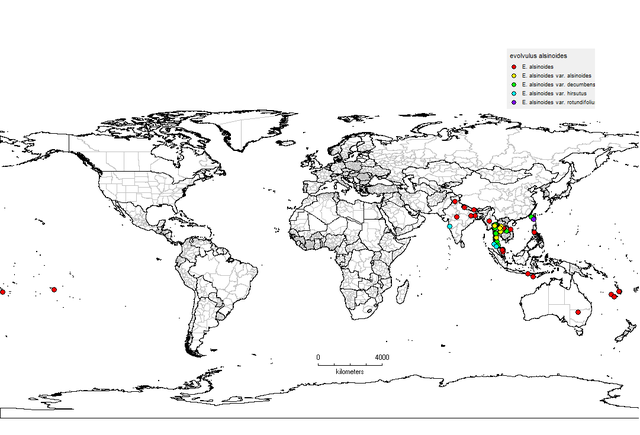Nomenclature
Evolvulus alsinoides (L.) L., Sp. Pl. ed. 2. 392. 1762.
Convolvulus alsinoides L., Sp. Pl. 1: 157. 1753.
Description
Fang R.C., G. Staples, et al. 1995. Convolvulaceae in P. Raven & C.Y. Wu (eds.) Flora of China 16: 271–325.
Cytology
Fang R.C., G. Staples, et al. 1995. Convolvulaceae in P. Raven & C.Y. Wu (eds.) Flora of China 16: 271–325.
Biogeography, Ecology and Natural History

China: Anhui, Fujian, Guangdong, Guangxi, Guizhou, Hainan, Hubei, Hunan, Jiangsu, Jiangxi, Qinghai, Sichuan, Taiwan, Xizang, Yunnan, Zhejiang.
Bangladesh, Cambodia, India, Indonesia, Japan (Ryukyu Islands), Laos, Malaysia, Myanmar, Nepal, Pakistan, Philippines, Thailand, Vietnam; Africa, Australia(Western Australia; Northen Territory; Queensland; New South Wales), North America, Pacific Islands, South America.
Growing on limestone, granitic, or sandy
soils in dry, sunny, open areas of savannah forest, dipterocarp forest,
seasonal deciduous forest, dipterocarp-oak seasonal hardwood forest, dry scrub,
sandy beaches, dry evergreen forest among granite boulders, as well as on roadsides,
in coconut plantations and other areas of human activity; altitude: sea level–400 m.
Flowering, fruiting year round.
Fang R.C., G. Staples, et al. 1995. Convolvulaceae in P. Raven & C.Y. Wu (eds.) Flora of China 16: 271–325.
Staples, G. 2010. Convolvulaceae. Fl. Thailand 10(3): 330–468.
Johnson, R.W. [unpublished]. Convolvulaceae In eFloraSA [Electronic Flora of South Australia]. http://www.flora.sa.gov.au/factsheets.html
Other information
This is a highly polymorphic species. Van Ooststroom (Meded. Bot. Mus. Herb. Rijks Univ. Utrecht 14: 1–267. 1934) recognized 16 varieties world-wide, based mostly on habit, leaf arrangement, and hairiness. Corolla color is variable; most often this is pale to vivid blue with a white central ‘eye’, but the entire corolla can be almost white. While there are local populations with distinctive phenotypes, there is a high level of intergradation between them and many intermediates exist that can’t be satisfactorily placed. This species appears well suited for study using molecular markers to determine whether any of the distinctive morphologies can be backed up by molecular characters.
Molecular Data
Fang R.C., G. Staples, et al. 1995. Convolvulaceae in P. Raven & C.Y. Wu (eds.) Flora of China 16: 271–325.
Authorship for webpage


Add new comment